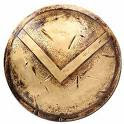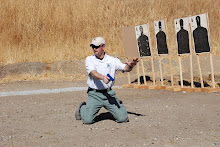I originally posted this article for LMS Defense in a monthly newsletter. It serves a purpose here as well.
Training Topics Ken Hardesty
Two Is One, One Is None
I am often asked by recruit officers that I train, “Sir, do you carry a back-up weapon, and if so what kind?” My answer is always a resounding, “Yes!”, and then the true discussion begins. The first part of the question must be answered with a few questions. Do you have 100% faith in your primary weapon to always work when needed? Do you wish to leave your fate in the hands of a mechanical device? Can you access your primary weapon with your non-dominant hand? If the answer to any of these is no, consider yourself in need of a secondary weapon. The doctrine that I preach, “two is one, one is none,” is not new, but it still holds true.In 2006, 146 police officers died in the line of duty. 49 of these were a result of gunfire. This is not to say that secondary weapons only apply to law enforcement personnel. Quite the contrary; every responsibly armed citizen should consider the option of carrying an additional weapon. If you are authorized to carry one weapon, why not carry two? Firearms manufacturers are making compact and sub-compact weapons smaller and more concealable.
Choices
Most of the major pistol manufacturers offer compact and sub-compact versions of full frame pistols. The two that commonly come to mind are Glock and Sig-Sauer. For instance, a 9MM Glock Model 19 or 26 will accept full size magazines made for the Model 17. Before spending your hard earned dollars on a secondary weapon, you need to determine what your purchase will be used for. Will it also serve as an off-duty/concealed carry sidearm? If choosing a dual purpose weapon, also consider such things as spare magazine/speed loader placement when off-duty and where and how you plan to carry concealed. If you are choosing a weapon for backup purposes only, I recommend a weapon that will accept the full size magazines of your duty weapon.
More Choices
Once you have the weapon picked out, how do you wear it? This is where the real decision – and sometimes argument – comes in. For off-duty/concealed carry purposes, I recommend a dominant side, belt supported holster. You have the choice of outside or inside the waistband. For hot summer days with shorts and t-shirt, an inside the waistband holster is ideal for concealment. For on-duty, backup use, you have a multitude of options - all with pros and cons. One of the most common options in law enforcement circles is the ankle holster. Entire training classes could be taught on the various methods used to draw from an ankle holster. Some of the pros include high concealability, and comfort while wearing boots. A major con is that the weapon can easily become dislodged during intense activities as foot pursuits. As with any backup weapon, you must practice. Your training regimen must include drills that focus on bending and drawing the weapon from the ankle holster, while keeping your eyes on the threat area.I have known officers who carried backup revolvers in the back pocket of their non-dominant side. A simple elongation of the chosen back pocket allows them to comfortably carry a titanium or similar lightweight weapon in the pocket. Another option is the vest slot holster. Plain leather or nylon holsters are manufactured with strap slots on the rear side. The slots accept the straps used to secure body armor to the chest. A small backup weapon can be carried in this fashion on either side of the chest. The weapon is accessed through the front of the shirt.A Smith and Wesson 340PD revolver with its' Scandium alloy frame and Titanium cylinder makes for a painfully light weight .357 Magnum. My personal favorite, and the location that I have carried a backup weapon for years is known as the B.U.G. holster. The acronym stands for Back Up Gun. The B.U.G. holster is a simple yet very effective one piece nylon rig. It measures approximately three inches by three inches square. The set-up is sold as one piece and is stitched to the front of any type of personal body armor. The front of the holster has a fold down flap that is secured in place by Velcro® across the top. Once the flap is folded down, the interior contains a small internal holster. Sold in three sizes (small, medium and large), the holster will accept handguns ranging from the sub-compact Glock 26 to the full size Sig-Sauer 226. I have carried a backup weapon in just about every conceivable place and fashion. The B.U.G. ranks as my personal favorite due to its accessibility and low maintenance. I place the weapon in the holster at the beginning of the night, and never worry about it again. The system is also set up to allow a left or right handed draw. I have recommended this system to scores of recruit officers for all of these reasons.The bottom line is simple. You have a choice: the choice to carry one gun or two. When carrying two, your options are endless. If you choose to carry one, you essentially rest your fate in a mechanical device as mentioned above. You will not be concerned with comfort when faced with a life and death situation. You will, however, take comfort in knowing you have a secondary weapon should you need it. That choice is yours to make. Stay safe and take care of your equipment.
Monday, April 27, 2009
Subscribe to:
Posts (Atom)

